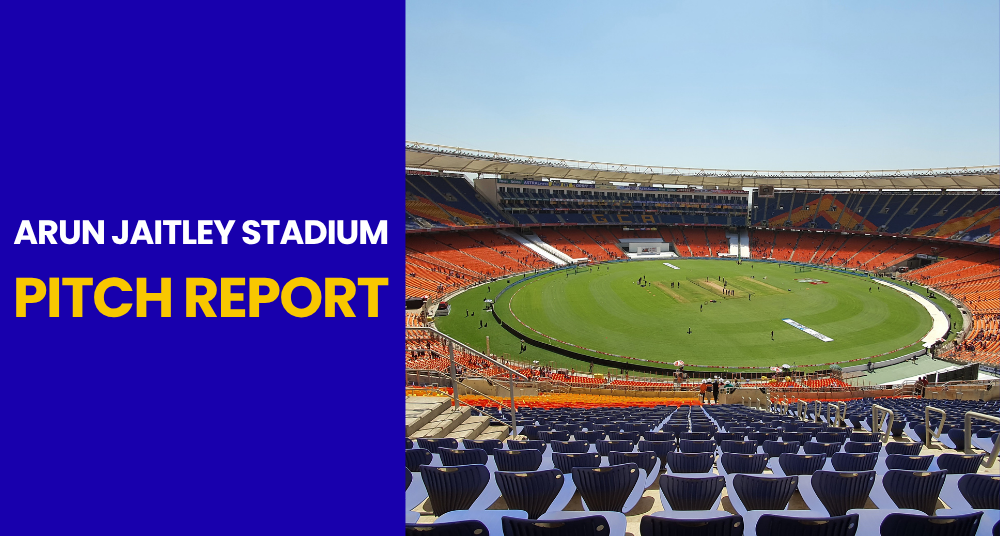Arun Jaitley Stadium, formerly known as Feroz Shah Kotla Ground, is one of India’s most iconic cricket venues. Located in the heart of Delhi, this stadium has a rich history and has witnessed countless memorable moments in Indian cricket. Established in 1883, it is among the oldest cricket grounds in the country, blending historical charm with modern facilities.
The stadium has a seating capacity of approximately 41,820 spectators, making it a lively venue for international matches. Over the years, it has hosted numerous Test matches, One Day Internationals (ODIs), and T20 Internationals, earning a reputation as a ground where records are made and exciting cricket unfolds.
Known for its passionate crowd, the Arun Jaitley Stadium has been the backdrop for several historic performances by legendary cricketers such as Sachin Tendulkar, Virat Kohli, and Anil Kumble. Its central location in Delhi also makes it easily accessible for fans and teams alike.
Beyond international cricket, the stadium serves as the home ground for the Delhi Capitals in the Indian Premier League (IPL), further cementing its status as a cricketing hub. Its combination of historical significance, modern amenities, and electrifying atmosphere makes it a must-watch venue for cricket enthusiasts.
Arun Jaitley Stadium Pitch Report – Key Characteristics
The Arun Jaitley Stadium pitch, located in Delhi, is known for its unique behavior that often tests both batsmen and bowlers. Over the years, it has gained a reputation as a balanced pitch, offering something for every type of player. Here’s a breakdown of its key characteristics:
1. Pitch Type
The pitch is generally hard and dry, with a consistent bounce that helps batsmen play long innings.
Early in the season, the pitch can have a slight green tinge, offering seam movement for fast bowlers.
As the season progresses, the surface tends to slow down, assisting spinners in extracting turn.
2. Batting Conditions
The pitch is considered batting-friendly during the initial overs of limited-overs matches.
In Test matches, it allows batsmen to settle in and build partnerships, especially on the first two days.
High-scoring games are common in ODIs and T20s due to the even bounce and predictable pace.
3. Bowling Conditions
Pace bowlers get early movement due to the slight moisture in the pitch, particularly in morning sessions.
As the match progresses, the surface tends to slow down, making it more favorable for spinners.
Reverse swing can also play a role in the later stages of a Test match, particularly under dry conditions.
4. Day vs. Night Impact
Day matches often see a true bounce helping batsmen.
For day-night matches, dew can make the outfield faster but slightly soften the pitch, reducing grip for spinners.
Batting or Bowling? Delhi Stadium Pitch Report
The Arun Jaitley Stadium pitch in Delhi is often described as a balanced surface, but historical trends show subtle advantages for both batsmen and bowlers under different conditions. Let’s break it down:
1. Batting Advantage
- In limited-overs formats (ODIs & T20s), the pitch generally favors batsmen due to its even bounce and true pace, allowing stroke play and high-scoring games.
- Batsmen can build partnerships easily on the first two days of Test matches, as the pitch is hard and flat initially.
- Several centuries and high team totals have been recorded here, proving its batting-friendly nature in early match stages.
2. Bowling Advantage
- Fast bowlers get early assistance from the pitch, especially in morning sessions where there might be slight moisture or grass cover.
- Spinners come into play in the later stages of the game as the pitch slows down and develops cracks, particularly during Test matches.
- Reverse swing often becomes a factor for pacers in dry, hot conditions, making it challenging for batsmen in the second innings.
3. Match Format Impact
| Format | Advantage | Notes |
| Test | Slightly balanced | Pacers early, spinners later |
| ODI | Batsmen | High scores common |
| T20 | Batsmen | True bounce favors stroke play |
4. Overall Verdict
While the Arun Jaitley Stadium pitch allows both batsmen and bowlers to shine, early sessions favor bowlers, and the middle overs or later stages favor batsmen and spinners. This makes it a strategically challenging ground for teams, requiring adaptability from both batting and bowling units.
Test Match Pitch Report at Arun Jaitley Stadium
The Arun Jaitley Stadium in Delhi offers a fascinating contest between bat and ball during Test matches. Known for its balanced pitch, it challenges both batsmen and bowlers, making it a venue where strategy and patience are crucial.
1. Early Sessions – Bowler-Friendly Conditions
- The pitch often has a slight green tinge in the first two days, providing seam and swing for fast bowlers.
- Pacers can extract movement off the surface, especially during morning sessions, making early wickets more likely.
- Teams winning the toss often choose to bowl first to exploit these conditions.
2. Middle Sessions – Batting Opportunity
- As the match progresses, the pitch flattens out, offering consistent bounce and pace for batsmen.
- Experienced batsmen can settle in, build partnerships, and capitalize on scoring opportunities.
- Centuries and big partnerships are common on days 2 and 3, provided the batsmen negotiate the initial seam movement.
3. Late Sessions – Spin Advantage
- By the fourth and fifth days, the pitch tends to slow down and develop cracks, favoring spin bowlers.
- Teams with quality spinners often use this period to apply pressure and take crucial wickets.
- Reverse swing also comes into play for pacers in dry and hot conditions, creating opportunities for late breakthroughs.
4. Historical Test Match Trends
- Average first-innings scores at Arun Jaitley Stadium typically range between 300–400 runs, indicating a batting-friendly pitch initially.
- Spinners like Anil Kumble and Ravichandran Ashwin have historically dominated in later innings.
- Matches often see a strategic battle between batsmen settling in and bowlers exploiting deteriorating conditions.
ODI Pitch Report at Arun Jaitley Stadium
The Arun Jaitley Stadium offers an exciting contest in One Day Internationals (ODIs), with conditions that often favor batsmen, but still provide opportunities for bowlers.
1. Batting Conditions
- The pitch generally has a hard and true surface, making stroke play easier for batsmen.
- High scores are common, with many matches crossing the 300-run mark.
- Batsmen who play straight and rotate the strike tend to succeed, as the surface provides predictable bounce throughout the innings.
2. Bowling Conditions
- Pace bowlers can get early movement, especially during the first 10 overs of the innings.
- Spinners become more effective in the middle overs as the ball grips the surface slightly.
- Dew in day-night matches can reduce the spinners’ effectiveness but makes it easier for batsmen in the second innings.
3. Scoring Trends
- Average first-innings scores at Arun Jaitley Stadium in ODIs are around 280–320 runs, indicating a batsman-friendly pitch.
- Teams batting second often find it easier due to the consistent pace and shorter boundaries, although dew can sometimes aid the chasing team.
4. Key Takeaways
- Winning the toss and choosing to bat first is often a strategic advantage.
- Aggressive batting in powerplays can set the tone for high totals.
- Bowlers need to adapt quickly, focusing on line, length, and variations to contain runs.
Final Words
| Statistic | Test | ODI | T20I |
|---|---|---|---|
| Matches | 134 | 404 | 56 |
| Runs | 12,400 | 14,234 | 1,382 |
| Average | 57.40 | 41.98 | 31.40 |
| Centuries (100s) | 38 | 25 | 0 |
| Half-Centuries (50s) | 52 | 93 | 8 |
| Highest Score | 319 | 169 | 66* |
The Arun Jaitley Stadium in Delhi is a venue that offers a balanced contest between bat and ball, making it one of India’s most exciting cricket grounds. Whether it’s a Test, ODI, or T20 match, understanding the pitch behavior is crucial for teams aiming to perform well here.
In Test matches, pacers get early assistance, batsmen can dominate the middle sessions, and spinners come into play in the later stages.
For ODIs and T20s, the pitch generally favors batsmen due to its consistent bounce and true pace, but smart bowling strategies can still turn games around.
Weather conditions, dew, and seasonal variations play an important role in influencing match outcomes at this stadium.



